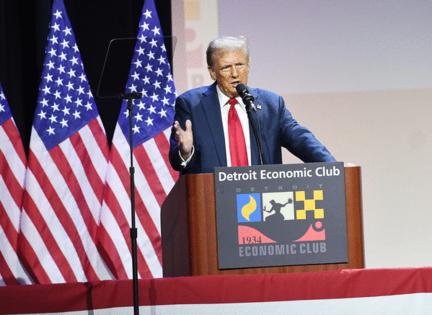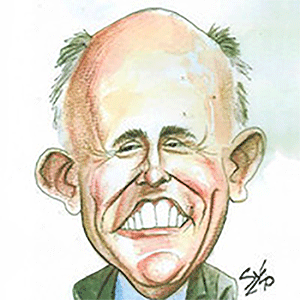Trump's auto loan tax break could save working class buyers thousands, experts say
Published in Automotive News
WASHINGTON — A Trump-backed tax holiday on auto loan interest payments could save middle-class Americans several hundred dollars apiece on new U.S.-built vehicle purchases through 2028, according to industry experts.
The break comes via a provision in the Republicans' One Big Beautiful Bill Act, a massive tax cut and spending package signed into law by President Donald Trump on July 4.
"Auto buyers got an above-the-line tax deduction. That's a rare beast in the zoo of tax policies," economist Patrick Anderson said. He also called it a "sharp U-turn in auto tax policy" from the Biden era, which featured electric vehicle credits used by more affluent customers.
There are strings attached to the provision, so not all customers and not all vehicles will qualify. But automakers and analysts alike have cheered the policy change as one that will benefit the working class and nudge buyers toward built-in-America vehicles.
"For the subset of taxpayers that are employed, earn between $50,000 and $100,000 in salary, and are ready to buy a new car, this could reduce their cost by between $300 and $900 per year, and for heavy borrowers, over $1,000 per year," Anderson's firm, the Lansing, Michigan-based Anderson Economic Group, wrote in an analysis of the new policy.
A separate analysis by automotive and industrial consultancy AlixPartners estimated similar benefits of up to $800 in each of the first and second years of auto loans when interest payments are highest, with total savings of approximately $3,000 over the full term of a given loan. The analysis also suggested that about 1.8 million borrowers per year could benefit.
"While the auto-loan interest deduction for domestically produced vehicles would of course benefit consumers directly, this measure could help out automakers and dealers as well — if it nudges affordability upward and helps sustain demand. The proof, as always tough, will be in the final pudding," said Akshay Baliga, a director in the automotive and industrial practice at AlixPartners.
Trump promised the auto loan tax break on the campaign trail last year, including during a speech to the Detroit Economic Club in October. At the time, he said the tax policy would help both automakers and consumers dealing with high prices across an industry that was "going out of business."
Since then, Michigan U.S. Rep. Bill Huizenga, a Republican, has been a champion of the policy in Congress. He introduced a bill on the topic in May titled the "Made in America Motors Act," which was later folded into the Republicans' broader budget package.
“Thanks to the No Tax on Auto Loan Interest included in the One Big Beautiful Bill, millions of Americans will find it more affordable to finance the purchase of a new car, minivan, truck, or SUV that is assembled in the United States,” Huizenga said in an emailed statement.
He added: “By reducing the federal tax burden by up to $10,000, this provision provides substantial relief to hardworking Americans, not just here in Michigan but across the nation, who have suffered from years of Bidenflation. Importantly, this provision will also spur on Michigan’s automotive sector and strengthen the good-paying jobs it supports across our state.”
The White House has given the auto loan tax break top billing in promoting the legislative package, touting it in social media posts alongside wider-reaching "no tax on tips" and "no tax on overtime" policies.
The average MSRP of a new vehicle in June was $51,124, according to Kelley Blue Book. That is the second-highest on record behind December 2024 ($51,990).
Policy basics
The provision applies "above the line," meaning that eligible tax filers will be able to take advantage of the break, even if they claim the widely used standard deduction on their annual federal submission.
Individuals earning less than $100,000 in modified adjusted gross income and couples earning less than $200,000 can get the full benefit of the tax break, but it gradually phases out for higher-income filers.
Anderson advised potential buyers to confirm their MAGI before making a purchase, since it tends to be higher than the more commonly known AGI. The Internal Revenue Service explains the difference on its website. The economist also advised buyers to double-check with dealers on where vehicles were assembled, since manufacturers often have different assembly locations for different trims of the same model.
For anyone under the income cap looking to use the new deduction, the following basic requirements apply:
—Purchases made in 2025 (including before July 4), 2026, 2027 and 2028
—No leases
—Final vehicle assembly completed in the United States
—Vehicle is either a car, minivan, van, sport utility vehicle, pickup truck, or motorcycle made for use on public streets
—Vehicle weight below 14,000 pounds
—Vehicle is new and for personal use
—Loan made by unrelated parties (no family loans)
The policy allows annual deductions of up to $10,000, though few filers are likely to claim deductions that high.
The deduction provides no benefit for cash-rich buyers who pay off their vehicle in full upon purchase, and limited benefit to buyers who agree to low-APR financing deals with minimal interest accruing.
The average interest rate on auto loans for borrowers with good to excellent credit (670 to 850 credit score) ranged from 5.18% to 6.70% in the first quarter of 2025, according to NerdWallet. For borrowers with nonprime or subprime credit (501-660), rates typically fall between 9.83% and 13.22%.
Those rates could rise and fall depending on the length of a loan, with shorter loans drawing lower rates and longer ones drawing higher ones. The most common auto loans are between five and seven years.
In practical terms, auto borrowers with strong credit who opt to buy a $30,000 vehicle, make a 20% down payment, and accept a 72-month loan would likely face annual interest payments between $1,200 and $1,700 for the first year of their loan. They could deduct a portion of that from their taxes and expect savings in the range of $140 and $360, depending on their federal income tax bracket.
A borrower with weaker but still fair credit participating in a similar transaction would save in the range of $290 to $710, though savings in all cases vary depending on a combination of vehicle price, down payment, loan terms and income.
Who benefits most?
Anderson said that the "sweet spot" for the new tax policy is "younger workers buying a first or second car, working families that need a family-hauler, and trade workers that need lower-trim trucks for their personal use."
His analysis included more than two dozen domestically assembled models that will likely benefit from the deduction, with several from Ford Motor Co., General Motors Co. and Stellantis NV. Those models include the Ford Bronco, Escape and lower-trim F-150s; Chevrolet Traverse, Colorado and lower-trim Silverado; and the Jeep Wrangler and Cherokee.
Anderson doubted that the luxury market would see much benefit, since buyers in that segment tend to have higher incomes. He also noted that lower- and medium-income buyers who choose to go into debt to purchase expensive cars will be able to deduct "substantial" interest, though their budgets will take a hit in the process.
A full list of eligible vehicles, Anderson predicted, will eventually be published by the IRS.
Ivan Drury, the director of insights for Edmunds, said the policy will most benefit buyers with poor credit who need to accept higher interest rates to get an auto loan.
Drury also predicted that some buyers might choose to put less money down at the time of purchase or opt into extended warranties or maintenance packages, knowing that they are in line for a tax break at the end of the year.
"I think for the dealership, this is very beneficial when someone is financing," he said. "It's another leverage point for a dealership to make things more enticing once you're already in there."
He also said the benefit is strong for consumers: "It's almost like, is it too good to be true? When you're paying interest, you're just paying the bank, right? You're not getting more car. Nobody wants to pay for the right to borrow."
Industry reaction
Drury called the new policy a welcome change for consumers but said it is unlikely to be a "volume buster" that supercharges auto sales.
"Is it going to make or break the numbers for an OEM or a dealership? Unlikely," he said. "But it will make consumers feel less sting when they see current interest rates, especially people who've been out of the market for over six years, which is the average age for trading a vehicle in for a new car."
Anderson's analysis also noted that the new deduction could help offset price increases from Trump's 25% tariffs on imported auto parts.
Several automakers and dealers have cheered the new tax break, including Ford Motor Co., which assembled about 80% of its vehicles in the United States last year.
“Customers can rest easy knowing America's best-selling trucks, the F-Series, are all assembled in America and qualify for this deduction," company spokesperson Robyn Jackson said in a statement. "As America’s top auto producer, we’re glad to see Congress and the Trump administration create policies that lower costs for customers and support the American auto industry at the same time.”
General Motors Co., which built about half of its vehicles in the United States, also celebrated the move. The manufacturer has launched dedicated landing pages for the tax breaks across its Chevy, GMC and Cadillac websites.
"GM and its brands have been the engine of growth for the US auto industry this year, and we don’t see that changing," company spokesperson Elizabeth Winter said in a statement.
Stellantis NV and the Alliance for Automotive Innovation, the industry's top lobbying group, declined to comment. The United Auto Workers did not immediately respond to a request for comment Thursday.
The National Auto Dealers Association suggested the policy might nudge sales upward with average new vehicle prices close to all-time highs. "The new provision allowing qualifying car buyers to deduct auto loan interest is designed to help offset some costs and make certain vehicles more affordable. As a result, it is expected to help stimulate car sales for the industry," spokesperson Amy Wright said.
Walt Tutak, the dealer trade inventory manager at Matthews-Hargreaves Chevrolet in Royal Oak, said the tax break was "a great thing" but did not expect it to boost sales significantly.
Tutak noted that his dealership leases about 70% of new vehicles, transactions that are not covered by the new policy. He suggested that some buyers might switch to purchasing because of their ability to deduct loan interest but expected the impact to be marginal.
"If you have to buy a car, you're going to buy it one way or the other," Tutak said in a phone interview. "I might be wrong, but I don't think it's gonna make any more sales. It's just gonna help the consumer."
©2025 www.detroitnews.com. Visit at detroitnews.com. Distributed by Tribune Content Agency, LLC.








Comments